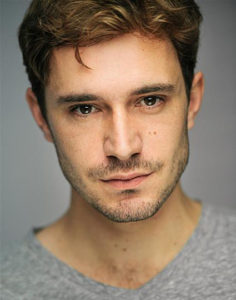
Samantha Womack and Oliver Farnworth who star in the tour of THE GIRL ON THE TRAIN, currently on tour, talk with the play’s director, Anthony Banks.
Thriller fans are clearly in for a treat when director Anthony Banks promises the stage adaptation of The Girl On The Train “is absolutely packed with twists and turns”. Anthony, after all, has a string of acclaimed thrillers to his credit but even he has to admit: “This has even more twists and turns than I’ve ever had to juggle before.”
Scripted by Rachel Wagstaff and Duncan Abel, the play is as an adaptation of Paula Hawkins’ 2015 bestselling novel. The 2016 film version starring Emily Blunt relocated the story to the United States but the stage version returns it to its UK roots.
It revolves around Rachel Watson, an unhappy alcoholic who thinks the couple she sees from her computer train every day are perfectly in love. Then the wife Megan disappears and, as Rachel inveigles her way into the life of Megan’s husband Scott, she finds herself both a witness and potential suspect.
Acclaimed for his direction of Strangers On A Train and Gaslight, set in the 1950s and 1930s respectively, Banks believes the fact The Girl On The Train is set in the present day, in familiar but unspecified locations, is an extra lure for theatregoers. “It’s instantly recognisable for that reason,” says the director, “and it could be your street, they could be your neighbours, this could be happening to you.”
He was intrigued by the visual potential of Hawkins’ plot, saying: “On stage we can play out a scene between two characters which is naturalistic and believable while showing something that contradicts it. It’s a crime drama that takes place across a week, each day they get closer to finding out who the perpetrator is and all the evidence is about images and identity.”
The action takes place in domestic spaces, like living rooms and kitchens, and of course there’s also a train. Anthony and designer James Cotterill (who previously collaborated on the drama Twilight Song) have taken inspiration from Rachel in the novel talking about having a black hole in her memory.
Before rehearsals the director met with Paula Hawkins and they talked about how Rachel is losing her grip on her identity because of the effect heavy drinking has on her short-term memory. “Because she can’t remember what happened last night or last week she starts to forget who she is. Her identity is eroding and she describes it as a black hole so the design is also a black hole in which appear domestic spaces, a train, a police cell, an interrogation room and also the wasteland by the train tracks where the body is found.”
Rachel is a dream role for Samantha Womack, who recalls being gripped by the novel when she read it, and also a challenging one. “There are about 70 pages of dialogue for me to learn,” says the actress best known for playing Ronnie Mitchell in EastEnders. “It’s like playing Hamlet.” Samantha smiles. “I never shut up.”
Having appeared in the West End in Guys And Dolls and toured in South Pacific and The Addams Family, Brighton-born Womack isn’t as worried by all that dialogue as she is about playing a convincing drunk. “It’s a really hard thing to do,” she says. “Drink is like a truth syrup that removes all the boundaries so rather than a comical element, with the slurring and slipping up, I think Rachel’s just completely unpredictable. It’s about what happens when she’s drunk and where does her brain go?”
 Womack is chatting during a break from rehearsals in an East London studio where she and co-star Oliver Farnworth (who plays Scott) have been running through an intense scene where tensions flare up between Rachel and Scott.
Womack is chatting during a break from rehearsals in an East London studio where she and co-star Oliver Farnworth (who plays Scott) have been running through an intense scene where tensions flare up between Rachel and Scott.
The break is also a welcome one for Coronation Street star Jack (he was Andy Carver on the soap until 2017), although he’s really enjoying sinking his acting teeth into the complex role of Scott. Careful not to give spoilers, Farnworth says: “Throughout the play you’re drip-fed more information about him so the audience gets to build up a case file. Has he been left by his wife? Has something happened to make her run away?”
Having been a bit of a bad lad in Corrie prior to which he was manipulative Will Hacket in Hollyoaks, the actor adds: “Roles like this are more interesting to me as an actor rather than playing the prince charming, nice guy, boyfriend-next-door sort of thing. I like roles that have a bit of meat and a bit of weight to them.”
Also in the cast are John Dougall as Detective Inspector Gaskill, who is investigating Megan’s disappearance, as well as Kirsty Oswald as Megan herself. Adam Jackson-Smith plays Rachel’s ex-husband Tom, Lowenna Melrose is his new wife Anna and Naeem Hayatt is Kamal, a therapist who may or may not have been having an affair with Megan.
It’s a tangled web they all weave, with Farnworth pointing out: “All the characters in the play are multi-faceted and complex and it’s not a goody/baddie story. All the characters are slightly flawed and that makes for interesting, exciting drama.”
West Yorkshire-born Oliver, who trained in Bristol and worked mainly in Liverpool (where Hollyoaks is filmed) and London in the likes of Mr Selfridge, enjoyed returning to his Northern roots for Corrie.
“It’s an iconic show, the team is great, you’re really well looked-after and I got to work with some legends,” he recalls. “I got to do the everyday Weatherfield stuff of working in the shops and going down the street in the rain but then I got to do car chases and stunts and be trapped in a burning building.”
Samantha, who came to fame as Mandy in the sitcom Game On and made her EastEnders debut in 2007, admits she misses her co-stars and crew. “I miss my EastEnders friends and family and they really are a family. You go through so much together – marriages, losses, births – and you become incredibly connected.”
Not being tied into a long-running soap allows her to do more theatre, although she confesses: “The unpredictability of my future is terrifying. Ten years ago when I went into EastEnders I was younger and you embrace the unknown. The older I get the scarier it is, although I’m learning to enjoy it again.”
If pushed Womack would choose stage work over TV. “I’m a control freak,” she grins. “From the minute I’m on stage it can’t be edited. I also love the immediacy of theatre.” Laughing about the appropriate analogy, she adds: “I love being on a train and not getting off until it’s done.”
Farnworth hasn’t toured with a show since Kes eight years ago and then it was only for eight weeks. “This is a much bigger tour and I’m looking forward to visiting places I haven’t been before. I’ve never been to Ireland, for example, and it’s always good to explore new places, spending a week there and getting under the skin of a place.”
Anthony Banks, meanwhile, feels even audiences familiar with the novel will be surprised by The Girl On The Train on stage. They haven’t changed key plot points but in the book there are three character narratives – namely those of Megan, Anna and Rachel – while on stage Rachel is the focal point.
“In the novel,” Banks elaborates, “the way that facts are revealed and the sort of drip-drip of that is through three fragmented chronologies. Here it’s more simple, told across six chronological days, but the scenes withhold information from the audience in hopefully a similarly experiential way to how the novel withholds information from the reader. It’s the same story but the presentation is different.”
Oliver accounts for the popularity of stage thrillers with: “People just like a good detective story, simple as that. Audiences like gasps and to be on the edge of their seats and they like to second guess. In the interval everyone will have their opinions and that’s brilliant.”
An expert in the genre, Banks adds that theatregoers are drawn to thrillers because they tap into our fascination with good and evil and a desire to know whodunnit. The specific hook with The Girl On The Train, he feels, is that it revolves around an anti-heroine. “And it’s fascinating for an audience to follow the journey of a protagonist like that.”
Samantha agrees. “There’s something about Rachel’s devil-may-care rebellion that appeals to lots of people. She says what you shouldn’t say, she thinks what you shouldn’t think, she’s a victim of circumstance and you have sympathy for her because of everything she’s been through.”
Anthony raves about his leading lady. “Samantha is outstanding and it’s a great collaboration because she is extremely thorough about understanding not only how her character works but also how all the characters and the whole concoction works.”
Rachel doesn’t leave the stage for the entire show. “And that terrifies me,” Womack admits. “I don’t always take things in at first and it wasn’t until the middle of rehearsals that it hit me that ‘Oh, it’s basically just one long scene for me’. I never get to leave the stage and regroup. One scene leads me straight into another and it’s like a dance.”
The actress agrees that the show has jolts and surprises whether or not you’ve read the novel. “Yes we’re replicating the story but there are changes and nuances that are very different. I hope that by the time they leave the theatre people been shaken about a bit.”
Farnworth agrees. The recipient of an Inside Soap Award for Best Shock Twist (for the revelation that Andy Carver, presumed murdered, was still alive) grins. “There are more twists than you can shake a stick at. Be prepared to be twisted!”
Production photograph by Manuel Harlan


